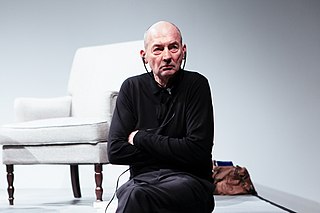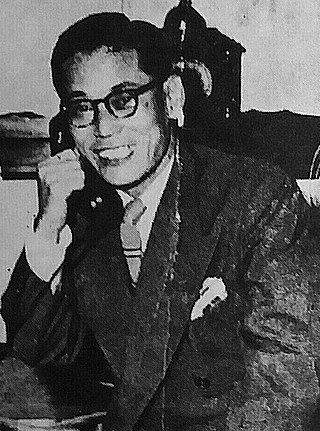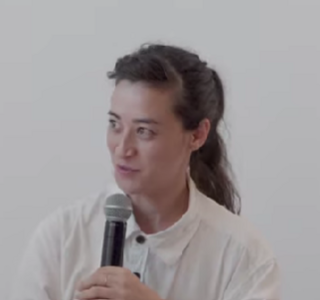
Mario Botta is a Swiss architect born in Mendrisio, Ticino on 1 April 1943. At age fifteen, Botta dropped out of secondary school and apprenticed with the architectural firm of Carloni and Camenisch in Lugano. After three years, he went to the Art College in Milan for his baccalaureate, and then to Università Iuav di Venezia for his professional degree in 1969. During his time in Venice, Botta got to meet and work with the architects: Carlo Scarpa, Louis Kahn and Le Corbusier. Mario Botta started his own architectural practice in Lugano in 1970.

Remment Lucas Koolhaas is a Dutch architect, architectural theorist, urbanist and Professor in Practice of Architecture and Urban Design at the Graduate School of Design at Harvard University. He is often cited as a representative of Deconstructivism and is the author of Delirious New York: A Retroactive Manifesto for Manhattan.

Nam June Paik was a South Korean artist. He worked with a variety of media and is considered to be the founder of video art. He is credited with the first use (1974) of the term "electronic super highway" to describe the future of telecommunications.

Lee Byung-chul was a South Korean businessman who founded the Samsung Group, the country's largest chaebol (conglomerate). Lee founded Samsung in 1938, at the age of 28. He is recognized as the most successful business magnate in South Korea's history.
Il Lee is a South Korean-born American contemporary artist. He was born in South Korea and has been living in America since the mid-1970s. Il Lee is best known for his ballpoint pen artwork; large-scale abstract imagery on paper and canvas. He also creates artwork in a similar vein utilizing acrylic and oil paint on canvas. Exhibitions of Il Lee's artwork have been held in Seoul, Tokyo, Hong Kong, Paris, New Delhi, Mexico City, and numerous cities across the United States. The New York Times has described Lee's ballpoint artwork as "deceptively casual; sweeping, rhythmical abstractions in blue."

The Seoul National University Museum of Art (SNUMoA) is a museum in Seoul National University.

Hannam-dong (Korean: 한남동) is a wealthy dong (neighborhood) of Yongsan District, Seoul, South Korea. It has been portrayed continuously in South Korea's popular culture as an oasis of wealth and luxury, thus becoming the subject of numerous domestic films, television series, and popular music references.
The Prada Transformer was a temporary, shape-shifting pavilion located in Seoul, South Korea. It had four different apparent shapes, depending on the function for which the pavilion is needed at the moment. The pavilion was commissioned by Prada and designed by Rem Koolhaas' architecture firm Office for Metropolitan Architecture. It was inaugurated in April 2009 and dismantled in October 2009.
Petra Blaisse is a British-born Dutch designer. Her work is an intersection of the professions of architecture, interior architecture, landscape architecture, textile design, and exhibition design.
Hervé Descottes is a French lighting designer, business owner and author. He established the lighting design firm L'Observatoire International in New York City in 1993 after eight years of design practice in Paris, France. Descottes personally creates the lighting concepts for all projects designed by L'Observatoire International, and oversees project development through project completion. He is the author of Ultimate Lighting Design and co-authored Architectural Lighting, Designing with Light and Space with Cecilia E. Ramos. Mr. Descottes has been recognized numerous times by the lighting design and architectural community. He has received awards from the International Association of Lighting Designers, the Illuminating Engineering Society and the New York City Illuminating Engineering Society, the American Institute of Architects, the American Society of Landscape Architects, D&ADAD, the Municipal Art Society of New York City, and the GE Corporation. In 2008, Descottes was named Chevalier of the Order of Arts and Letters by the French Minister of Culture for his work in lighting design.

The National Museum of Modern and Contemporary Art, Korea is a contemporary art museum with four branches in Gwacheon, Deoksugung, Seoul and Cheongju. The museum was first established in 1969 as the only national art museum in the country accommodating modern and contemporary art of Korea and international art of different time periods.
Kim Beom is a South Korean multimedia artist.

Lee Hun Chung (이헌정) is a South Korean artist. He is famous for working with ceramics and concrete in a wide range from small objects to large installations. Lee creates modern day pieces using techniques and colors dating back to the Joseon Dynasty. Lee attended Hong-ik University in Seoul from 1986–1991 with a BFA in ceramic sculpture. He continued his education throughout San Francisco and Korea, and getting a PH.D in architecture from Kyung-Won University in Gyeonggi-do, South Korea.
Sanghee Song is a South Korean artist. Sanghee Song was born in Seoul in 1970. She attended Ewha Womans University, earning her BFA in painting in 1992 and her MFA in 1994. Her works challenge the myths and repetitive narrativity of virtuous women. For her 2004 video The National Theater, Song reenacted the assassination of Yuk Young-soo, wife of South Korean president Park Chung-hee.
Cho Yong-ik was a South Korean artist. He was a leading figure in Korean abstract painting along with Kim Tschang Yeul, Park Seo-bo, and Chung Sang-Hwa.
Hong Ra-hee is a South Korean billionaire businesswoman who is the director of Leeum, Samsung Museum of Art. She is the widow of Lee Kun-hee, who was the richest person in South Korea. She is known as the most powerful art collector in South Korea. She is among the richest people in South Korea. In December 2024, Forbes estimated her net wealth at US$3.1 billion and ranked her 7th richest in the country.

The dragon's head and wind chime is an elaborate type of gilt bronze Korean wind chime and Korean dragon sculpture of later Silla / early Goryeo art, probably serving as a roof end tile figure on a Korean Buddhist temple or Korean palace. There are two similar near-complete examples, at the Metropolitan Museum of Art in New York City, and at Leeum, Samsung Museum of Art in Seoul, which is designated National Treasure No. 781.

Gala Porras-Kim is a Colombian-Korean-American contemporary interdisciplinary artist who lives and works in Los Angeles and London. Her work deals with the fields of linguistics, history, and conservation, often engaging in institutional critique.
The House series was produced by Roy Lichtenstein in the late 1990s and consists of several large-scale outdoor sculptures and an interior wall piece. The House series includes three distinct works: House I, House II, and House III. Each piece depicts the exterior of a simplified cartoon house, while actively producing an optical illusion. Houses I and III are available for display at the National Gallery of Art Sculpture Garden in Washington, D.C., and the High Museum of Art in Atlanta, GA, respectively. No records indicate the current location of House II.

Suki Seokyeong Kang (강서경) is a visual artist based in Seoul, Korea. Kang's practice traverses painting, sculpture, performance, video and installation. Inspired by cultural traditions of Korea as well as contemporary artistic and literary discourses. Kang decodes rules and values that govern these disciplines, turning to artistic languages of the past to construct a contextual lens through which she explores the notion of individuality and freedom in the present moment.















